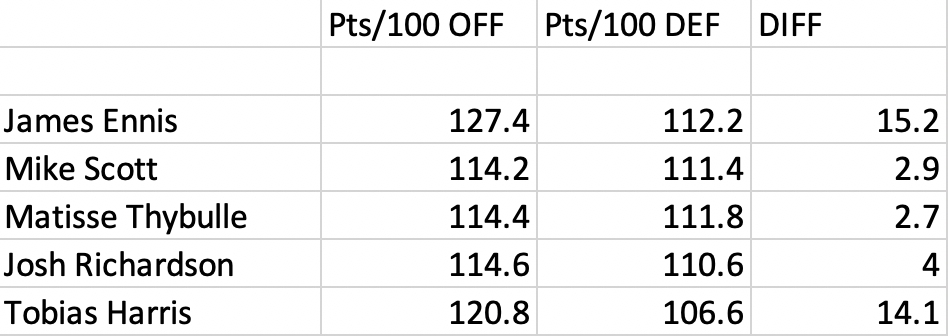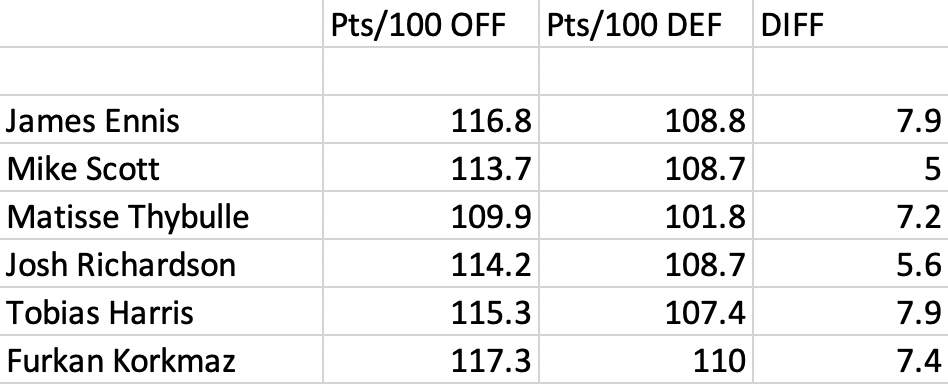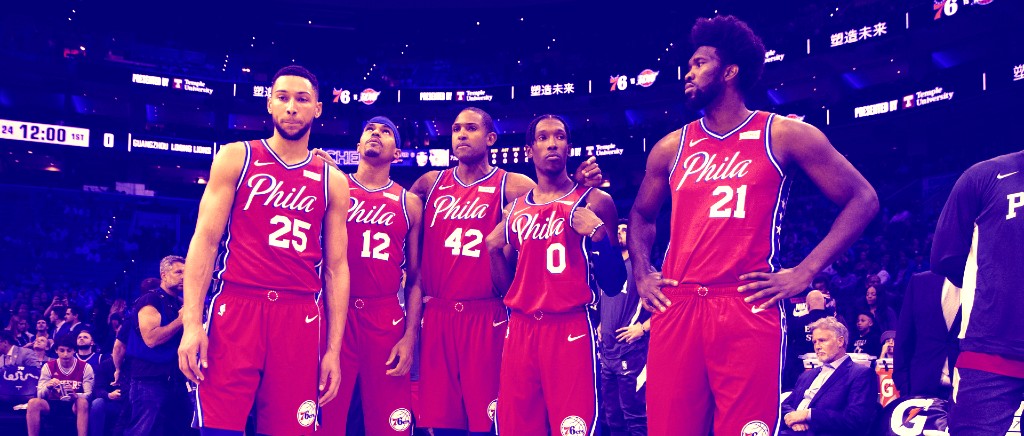The past decade or so of Philadelphia 76ers basketball have been defined by weirdness. To wit, and this is an incomplete list: The Process, the most blatant and unrepentant effort of tanking in NBA history, a general manager (or his wife it’s still not fully clear) having multiple burner Twitter accounts which were used to rip current and former players along with his predecessor, that general manager only getting in because of a hostile takeover orchestrated by his guy’s dad, a whole lot of injuries, a whole lot of missed or passed-up threes taken by back-to-back No. 1 draft picks, an emphasis on building a roster of ginormous people, etc. It’s a long list, and I may have touched on like 25 percent of things that could have gone in this paragraph.
All of this is to say, despite the fact that this was supposed to be the year that things coalesced and the Sixers became one of the favorites to win an NBA championship, Philly has been perhaps the weirdest team in all of basketball, because literally no other outcome would make sense.
Everything starts with a simple fact: There are two Sixers teams, based entirely on where games are played. At the familiar confines of the Wells Fargo Center, Philly is a league-best 25-2 with an offensive rating of 111.7, a league-best home defensive rating of 101.9, and a net rating of 9.9, the fourth-highest mark in the league. They lost to a pair of playoff teams — the Miami Heat and the Luka Doncic-less Dallas Mavericks — in back-to-back home games in December and have otherwise been flawless in their crib.
When they go play somewhere else, though, the team craters. Philadelphia is 9-19 away from their building and have not won on the road since Jan. 20. Seeing as how their next road game is against the Bucks on Feb. 22, they will go at least a month between road wins, although winning in Milwaukee against another extremely strong home squad would take a herculean effort. In road games, the Sixers’ offense collapses (ORtg of 105.2, the sixth-worst road mark in the league), and while their 110.3 DRtg is ninth-best in the league, it’s still a major drop-off from what they’re capable of producing, and as such, the team as a whole struggles.
Teams being better at home than they are on the road is hardly a surprise, but teams going from “championship contender” to “the same road record as the Knicks” away from their building is totally stunning.
Early on, there was the belief that their struggles were simply an issue of needing time to become a cohesive group, and because the Sixers have so much talent, size, and physicality they’d come together and the concept of them losing four out of seven games in a playoff series is going to be really hard. There is something to that — when games slow down in the postseason, Philly has a collection of battering rams, even if their half-court offense sometimes suffers from a serious lack of spacing (please see Exhibit A) — but as Brown has expressed, there are concerns about how long that has taken and that certain poor habits are forming with the apparent complacency and disinterest they show at times in the regular season.
“I definitely see it out of them, and it’s not acceptable. I completely coach and live life thinking good things add up, you don’t just click your heels and April 14th is here. That’s not how I see anything, and we shared that notion today,” Brown said last month, per Kyle Neubeck of Philly Voice. “That’s stuff where I need to continually remind them, at times maybe remind them more than I have. There are so many bullets you feel as a head coach in the NBA you’ve got, I fire them responsibly.”
Part of the issue has been the sheer lack of games/minutes for the team’s perceived starting five of Ben Simmons, Josh Richardson, Tobias Harris, Al Horford, and Joel Embiid. That group, per NBA.com, has appeared in 21 games together for a combined 244 minutes. That last number is 20th in the league among five-man unites, but seeing as how it includes a pair of players acquired over the offseason in Richardson and Horford, building up as much chemistry as possible is paramount. The grouping has been solid — Cleaning the Glass puts it in the 69th percentile of lineups in terms of point differential per 100 possessions — but Brown also made a long-speculated move to tweak the team’s starters on Tuesday night’s win over the 110-103 win over the Los Angeles Clippers, sliding Horford to the bench for the floor spacing provided by 22-year-old Turkish wing Furkan Korkmaz.
Is it weird to put Horford, who signed a four-year max deal with the squad this past summer, on the bench for a guy who makes $1.6 million a year? Of course it does, but Horford’s fit has been a bit tenuous all season long. He’s a wonderful basketball player who has the unfortunate distinction of being on a team whose offense craters when he’s on the floor next to his two-best teammates.
Per Cleaning the Glass, when Embiid, Simmons, and Horford all share the floor together, Philly’s offense scores 99.3 points per 100 possessions, which places them in the third percentile of all groupings. The good news is their defense is sublime — 100 points per 100 possessions, in the 98th percentile — the bad news is that you can do math and come to the conclusion that those groupings are being outscored.
While the sample size is smaller, the 309 minutes in which Horford has been on the bench while Korkmaz plays alongside Embiid/Simmons has seen the defense struggle (111.5 points per 100 possessions) and the offense explode (115.9 points per 100 possessions). This is not something that is limited to Korkmaz — here is how Philly looks in the minutes where Embiid and Simmons are flanked by a different player on the roster with Horford on the bench.

And here is how these numbers look when you run all of these but swap Embiid and Horford. You can probably guess what is about to happen.

So, it stands to reason that Philadelphia is at its best when it is limiting the amount of time it is not playing two centers and its 6’10 point guard at the same time. The exception to this would be — as the team probably anticipated — in the moments where the Sixers have to lock teams down, and with their size, they’re uniquely positioned to be able to throw haymakers against a team like the Bucks, or the Lakers, or the Clippers … if, of course, they can get to points (especially on the road) where they can play that way.
A second frequent refrain, along with “they’ll just flip a switch,” is that Philly would benefit from having Horford come off the bench and limiting the amount of minutes he and Embiid spend on the floor. The numbers show that there might be something to this, and in the pace-and-space era, it makes all the sense in the world that playing two centers would be a way to sacrifice space to operate on offense for extra stinginess on defense.
Perhaps Tuesday’s game, with Horford coming off the bench and only playing nine minutes next to Embiid (the fewest either guy played next to another starter), is something they can do more of as the year progresses. There are plenty of other options, whether it’s Ennis, Korkmaz, Scott, Thybulle, or one of their two newcomers from the Golden State Warriors, Alec Burks and Glenn Robinson III. Korkmaz has been the best shooter of the bunch, if they’d like to toss in someone who can fill the role left by J.J. Redick, so it makes sense why he would get the first look.
Consistency has to be the goal for Philly moving forward, and moving Horford to the bench is what they hope can stabilize their play. Currently, the Sixers oscillate between being an elite basketball team and a squad that risks getting bounced in the first round of the postseason. For all their success at home, the Sixers sit in fifth in the East, two games behind the fourth-place Miami Heat, and risk not having home court at any point in the playoffs. The good news is that they have one of the league’s easiest schedules after the All-Star break, and Brown has expressed that he won’t hesitate to shake things up when the team returns from the upcoming slate of days off.
“One thing I’ve learned is that there has got to be candid conversations with the team when we get back from the All-Star break, declaring, ‘This is how we see your world,’” Brown recently said, according to Jack McCaffrey of the Delco Times. “There is a time frame when things will level out and rotations will settle in.”
The Sixers are no strangers to wrapping up regular seasons on high notes. Back in 2018, they famously ended the year ripping off a 16-game winning streak, and last year, the team went 12-6 after the break before Embiid broke a bone in his face and had to miss the final six games of the season. There’s an importance in trying to replicate that sort of success during the closing stretch of this season with how damning their record is away from home — with some luck, perhaps they can make up the four games between themselves and the third-seeded Celtics — but what might be more important is ironing out these various wrinkles before the playoffs roll around.
There are signs that, when everything comes together, Philadelphia can be a juggernaut, the kind of squad that rightly was considered a championship contender and a mismatch for all of the other elite teams in the league. Their beatdown of the Bucks on Christmas Day was stunning, and their 12-point margin of victory didn’t quite reflect how good the Sixers were on the afternoon. Those highs have just been followed by stunning lows, like their four-game losing streak immediately following their big holiday win.
As such, one can argue that the team’s final 27 games should be used to endlessly tinker and gather as much information as they possibly can before the postseason rolls around. Threading the needle between “trying to win games” and “trying to win 16 games in the spring” is always difficult, but this team has always going to be judged by how it performs in the playoffs. The end goal is finding the appropriate balance between offense and defense, a challenge they’ve yet to figure out with any sort of regularity.
There’s no guarantee doing something unconventional — like putting a guy like Horford, who makes $28 million a year, on the bench and saving his minutes alongside Embiid for when the team has to clamp down defensively — will be the remedy that cures all ails. But if there is one thing the Sixers have always been good at, it’s been embracing the weird. It’s been their brand over the last few years, and at this point, there are worse ideas than staying the course on what has worked out pretty well lately.







